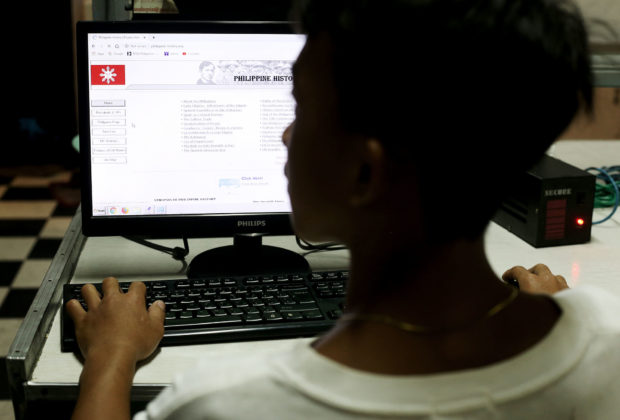Metro Manila schools cope by holding online classes

CLASSES IN THE CLOUD This time around, parents can’t just scold students for “spending too much time’’ on the computer at home. —RICHARD A. REYES
MANILA, Philippines — Holding online classes in the time of COVID-19 can be unexpectedly funny and seriously challenging at the same time.
A tweet about inadvertently recorded ambient remarks during a digital class has since gone viral after several schools and universities started using online teaching platforms because of the monthlong class suspension meant to contain the novel coronavirus.
“Pakioff ang mic, may tumatahol na aso. (Please turn off the mic; a dog is barking) … Bakit may jeep na bumubusina? (Why is there a jeepney honking its horn?)” were some of the comments posted during an online class lecture delivered through the University of Santo Tomas’ (UST) Cloud Campus.
The steep learning curve at mastering available online platforms among teachers and the uneven access to digital technology among students were the other challenges cited by professors who must cope with the school shutdown until April 12.
In a memorandum issued on March 12, UST Faculty of Civil Law dean Nilo Divina ordered law professors to adopt alternative teaching methods to continue their classes without face-to-face interaction.
Article continues after this advertisement“I leave it up to your sense of creativity and initiative on what you consider the best way to … ensure productivity during this period when traditional pedagogy is not possible,” the memo stated.
Article continues after this advertisementIt’s advice that Victoria Loanzon, a professor at UST, Far Eastern University and Manila Law College, takes seriously, as she prepares weekly learning modules and drill questions for her 12 classes.
Dr. Jules Meneses, Rizal Technological University’s (RTU) vice president for planning, research and extension services, said RTU provides its professors online platforms like Google Classroom for uploading activities, exercises and modules, and YouTube for online lectures. Adjusting well
But that may not be enough to ensure a seamless shift to online teaching platforms, said professor Nilmar Moreno, director of RTU’s curriculum and instructional resources development center, who said that guidelines were still being crafted to introduce the technology to a few seasoned professors who “are not even capable of opening an email.”
Some professors have adjusted quite well, however.
Aaron Philip dela Cruz, who teaches at the Filipino department of the Ateneo de Manila University (Admu) has transformed his bedroom in Plaridel, Bulacan province, into an online teaching workspace.
His setup is simple: He takes videos of himself giving a lecture using his laptop camera while his PowerPoint presentation flashes on a TV screen behind him. He then posts these videos to his Google Classroom, a virtual group with his students, after which he gives them guide questions and an assessment form.
Learning mix
“I make sure that each video clip won’t exceed 10 minutes because the file size will be too large for me to upload. I also don’t want to bore my students with one-hour long footage of me talking,” Dela Cruz said.
He said Admu had already instructed its teachers to conduct a dry run of online learning and work from March 12 to March 18, which means transitioning to “virtual classrooms,” such as Moodle, Schoology, Google Meets and Google Classroom.
At the University of the Philippines (UP), vice president for academic affairs Maria Cynthia Rose Bautista has also instructed the faculty to try a mix of learning in classroom and virtual settings, as only 30 percent of the faculty in UP campuses use the existing platforms.
To help them out, UP Open University, a cyber university that offers open and distance eLearning (ODeL), has offered a special set of online classes for teachers and students who are now shifting to the online mode of instruction.Connectivity issues
At the De La Salle-College of Saint Benilde (CSB), faculty members use BigSky Benilde to stream and embed videos and even interact with students, said Rogelio dela Cruz Jr., head of the school’s Center for Instruction, Research and Curriculum.
UST’s Blackboard Learning Management System, meanwhile, enables teachers to provide homework materials and assess their students. Aside from a panel that shows who among the students have logged in for the class, these students can also virtually raise their hand at the click of a button, or even break into groups.
But while going online can be a cost and time-effective alternative to traditional learning approaches, several professors have expressed reservations about it due to connectivity issues.
“This [alternative] is critical on our end since RTU is a state university and not all students have access to the internet,” said RTU professor JP de Leon.
Assessing a student’s capacity to participate is crucial, agreed Athena Presto, an instructor at the UP Department of Sociology.
There’s also a digital divide between technology-savvy students and instructors who are not fully comfortable with the system, said CSB’s Dela Cruz.
“Some teachers find it a challenge to create quality digital contents … Small steps should be done like training teachers to convert their contents properly,” he said. Students with slow internet connections “can make use of text messaging to [comply with] the activities or send clarifications and questions through email,” Meneses suggested.
“We really need to be very considerate [while making] sure that the flow and delivery of lessons are not hampered,” he added.
For more news about the novel coronavirus click here.
What you need to know about Coronavirus.
For more information on COVID-19, call the DOH Hotline: (02) 86517800 local 1149/1150.
The Inquirer Foundation supports our healthcare frontliners and is still accepting cash donations to be deposited at Banco de Oro (BDO) current account #007960018860 or donate through PayMaya using this link.